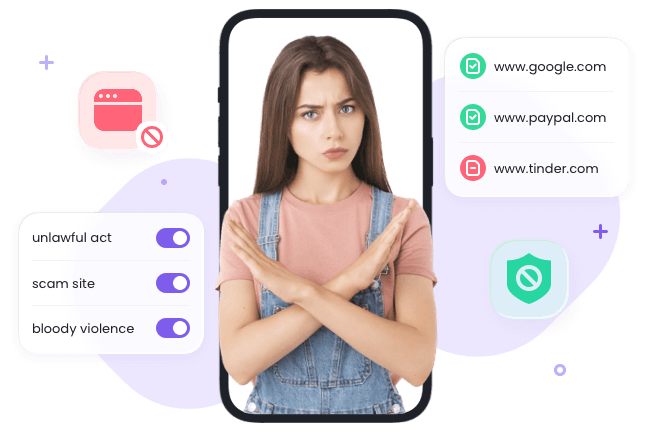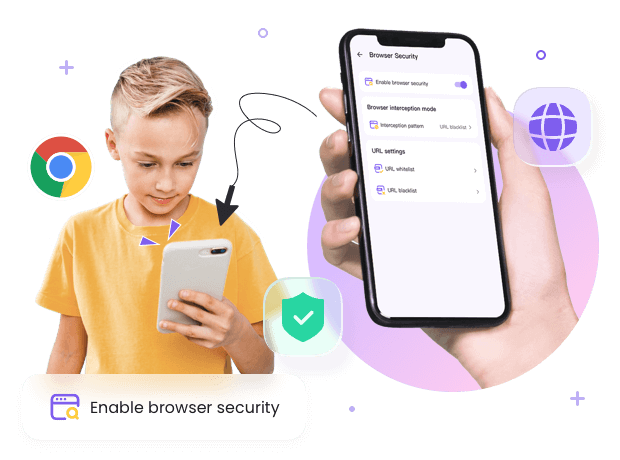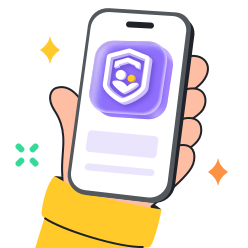The internet offers a great means of education and communication. Children enjoy it in their daily routines for school, play and to explore. However, a part of inappropriate websites and hidden spaces also puts them into danger, which may damage their psychological and emotional health. Open access to such websites exposes kids to violence, explicit content, and even predators. As the first line of defense for children’s safety, parents need to understand the risks posed by inappropriate websites and take effective measures to block them.
This article is a clear guide for parents who want to protect their kids from harmful content online. It focuses on the most risky category and offers effective measures to make internet surfing safer. It is not aimed at holding back curiosity, but prevents young minds from dangerous influences and contact.
What websites should be blocked for kids?
Many reports by eSafety Commissioner state that a high proportion (nearly half) of children between 9 and 16 experience regular exposure to sexual images. Similarly, kids are presented with explicit ads and even suggestive streamers when they are just browsing for gaming content or something to pass the time with.
The inappropriateness of the websites will also depend on the child’s age and maturity. What is appropriate among teenagers may not be appropriate for kids under 10. Restrictions need to be specific to the parents based on their understanding of their child’s development.



These are standards that explain why some websites are not safe for children and should be blocked.
Age-inappropriate content
The most evident threats are websites containing adult or explicit material. There are pornography, violent media, and games with a mature theme. This type of content distorts the views on relationships, agreement, and personal limits. Researchers associate the exposure to explicit materials at an early age with anxiety and sexually related confusion.
Young people are also exposed to graphic violence in gaming or on streaming websites, which may desensitize empathy and normalize aggression. Banning these sites is one way of ensuring emotional health and growth.
Cyberbullying and predators
Open social sites tend to attract cyberbullies and internet predators. Chat rooms, message boards, and gaming communities can expose kids to harassment or grooming.
Potential for addiction
Digital addiction is a rising problem with children and teens. Both games and social media platforms capture users’ interest through algorithms. Overuse has effects on sleep, school performance and social relations.
A Common Sense Media report revealed that among kids ages 8-12, the average daily time spent online is nearly 5 hours, excluding school hours. Many struggle to disconnect. Parents should block or restrict access to sites that exploit addictive behaviors.
Malware and phishing risks
Unsafe websites often contain malware or phishing traps. The children can accidentally open the pop-ups or install infected files. All these activities have the potential of harming confidential information, such as family details.
False news and misinformation
Misinformation is particularly dangerous in children. There are numerous websites that give misleading facts or one-sided views that are perceived as the truth. Exposure to conspiracy theories or false health advice can affect judgment.
Know what to block – and how, with a complete guide and parental control tips.
Top inappropriate categories & list of websites to block
The internet is massive, and not every place is safe for children. Some spaces are always very dangerous because of the nature or the audience. The following are the best categories of sites to block, restrict, or even regulate.
Adult porn and dating sites
One of the worst sites that is damaging to children is adult content sites. They consist of explicit visuals, videos and sexual content. Repeat exposure skews the image of intimacy and body image. Pornography may also fuel unrealistic expectations and emotional confusion.
Blocked websites for kids must include:
Minors should not date using websites. Even the non-explicit dating apps can expose the kids to adult interactions. Luckily, Filters or parental control applications can automatically block such domains.
Unblocked game sites
Gaming is not inherently bad, but unregulated ones may be harmful. Web filters or parental protection systems often fail to block many of these sites. What they usually do is have violent, sexualized content or games involving gambling.
Examples include:
- UnblockedGames77Play
- CoolMathGames (has a few age-inappropriate ads)
- Unblocked Games Pod
These sites have numerous pop-ups, adverts, and external links. They can also install cookies or malware. It is the responsibility of parents to ensure that children use only age-appropriate gaming platforms.
Gambling sites
Online gambling is very addictive and it is also unlawful among minors. These sites use graphics and easy wins to lure players. They are able to normalize risky financial behavior and promote compulsive behaviors.
Examples include:
- Bet365
- PokerStars
- 888Casino
- DraftKings
- BetOnline
- FreeSpin
- Bovada
- SlotoCash
- Stake
- RoyalAceCasino
By blocking the gambling sites, it is possible to avoid exposure to manipulative incentives. It also secures credit card details against theft and misappropriation.
Less-regulated chat rooms and social media
There are social media platforms that are loosely run to promote anonymity and spontaneity. They enable people who have never met to interact without any difficulties and they do not always check the ages of users. Such an environment poses threats of exposure to harassment, grooming, and harmful content.
Parents should treat certain platforms carefully:
- Discord
- Reddit (mature subreddits)
- Kik Messenger
- Omegle clones
- PalTalk
- TalkWithStranger
- ChatRoulette
- Chat-Avenue
Also, such mainstream platforms as Instagram or TikTok can subject children to cyberbullying and unsuitable trends. Parents should monitor account creation and restrict screen time.
Illegal streaming or pirated content websites
Piracy sites are websites that provide copyrighted movies, music and software without permission. Malware and misleading information are also common in these sites. They can also include pop-ups to adult content or scams.
Examples include:
- 123Movies
- Putlocker
- FMovies
- The Pirate Bay
- DarkWebLinks
- HackThisSite
Blocking these domains protects children from harm and prevents unauthorized downloads that could cause legal issues. Parents are to promote safe and legal streaming services such as Netflix Kids or Disney+.
How to block inappropriate websites on a child’s phone?
Blocking websites works best when targeted at a child’s device. Filtering tools and parental controls help parents monitor children’s online behavior without constant supervision. Each of the major smartphone platforms contains built-in means of controlling restrictions.
In-built features of iOS and Android phones
iOS devices:
The feature of Screen Time in Apple lets parents block certain websites and restrict the usage of apps. To set it up:
- Click on Screen Time > Content and Privacy restrictions.
- Allow Web Content Content Restrictions.
- Select either the option of “Limit Adult Websites” or “Allowed Websites Only.”
- Add a block or allow list of specific URLs.



Android devices:
Android has parental features in the form of Family Link. Parents are able to control their child’s browsing of features and access certain apps. Steps include:
- Install Google Family Link on both devices for parents and children.
- Install supervision and select Filters on Google Chrome.
- Block adult websites automatically or add custom restrictions to websites.
These settings are silent and block access to dangerous materials on browsers.
Third-party parental control applications
Third-party tools offer advanced control and monitoring. They have the ability to monitor screen time and content and report on the activity. Tools like FlashGet Kids have long been dominating the market when it comes to keeping kids safe in the digital world. The detailed setup guide for FlashGet Kids is here.
The following are basic steps to block risky sites on your child’s phone via parental controls.



- Download and install the corresponding FlashGet Kids apps on both devices.
- Pair the child’s device with the parent’s phone by following the in-app instructions.
- Click “Browser Safety” > “Enable Browser Safety” from the dashboard.
- Go to the URL Settings, where you can customize the URL Blacklist.
Consider FlashGet Kids a one-stop parental control tool that takes the stress off parents. It is like a digital nanny that will always oversee your child’s internet adventures and alert you when your child are in danger or exposed to something dangerous.
How to block websites on Chrome?
Google Chrome is a browser for Android and desktops. Parents can implement restrictions using browser settings or extensions.
Method 1: Enable SafeSearch
- Go to Google Search settings.
- Enable SafeSearch.
Use parental controls PINs to prevent kids from making changes.
Technique 2: Chrome extensions
- Parents can use extensions like BlockSite or StayFocused to blacklist certain URLs.
- Go to the Chrome Web Store and add a filtering extension.
- Add URLs manually to the block list.
- Turn on password protection to avoid deletion.
These measures are an added protection for the gadgets that children browse on Chrome as a daily routine.
Bonus tips for parents to enhance kids’ online safety
Technology cannot replace active parenting. The most effective measures for ensuring long-term digital safety are preventive behavior and effective communication.
Open discussions and set clear rules
Promote open conversations with your child and build trust, so they can ask questions and seek help when facing uncomfortable online experiences. Do not be judgmental or discipline them on first impression. Place time restrictions on device use and online activities together. Fun and high-quality family time minimizes fatigue and screen addiction.
Enlighten children on internet consciousness
Show children to be skeptical of what they know on the internet. Parents should encourage children to think before giving out information. Get them to understand the privacy options and the importance of using strong passwords.
Define what digital footprints are. Make them understand that when something has been shared, it might be left on the internet forever. Awareness creates responsibility.
Regularly checking browsing history
Verification of the browsing creates transparency. It also assists the parents in identifying early unsafe behaviour. Parents can combine frequent reviews with open discussion rather than resorting to punishment.
Choose kid-friendly platforms
Use kid-friendly search engines and websites. Educational and controlled platforms such as YouTube Kids, PBS Kids, and National Geographic Kids are great and provide a controlled environment.
Stay updated on new trends and platforms
The trends on the internet are volatile. Developers create new applications and websites every day, and some aim to bypass filters. The parents are to remain informed with online safety blogs, school initiatives, and cybersecurity news.
Although blocking sites is necessary, this must not be the only measure. Encourage critical thinking and praise children to make decisions independently. They will have to acquire digital responsibility over time without relying solely on filters.
Final thoughts
The Internet presents countless possibilities and threats. The first step towards that balance would be to identify inappropriate websites to block, ensuring children enjoy the benefits of technology without being influenced by bad content.
Adult content on unregulated social media is a very different threat. The proper blocking requires robust monitoring and restrictive tools. Integrated controls, third-party applications like FlashGet Kids, and Chrome filters are some of the essential ones.
However, internet security does not have a one-time fix. It is a process that is progressive with technology. So, parents should use digital tools with instructions, training, and interaction.
Parents can achieve this by being proactive and ensuring that children use the internet safely. It aims at bringing up digitally awakened, responsible and confident youth users who know the strength as well as the boundaries of the virtual world.

